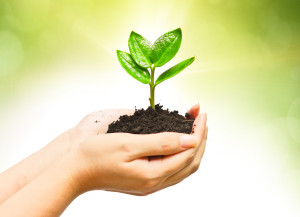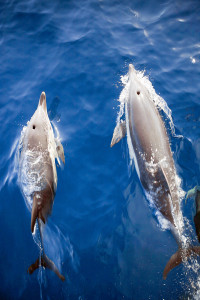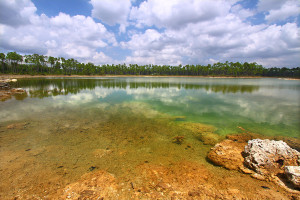
Picture this: you’re coasting along the waters of the Everglades and suddenly you notice tiny neon blue lights gleaming in the boat’s wake like a whole galaxy of stars. The water glows so profoundly it’s as if you’ve awakened it from a deep slumber. It’s almost as if it’s alive. Well, it is. This is called bioluminescence.
While the water isn’t actually alive, the tiny neon lights are. Bioluminescence in the Everglades is the product of light-emitting aquatic microorganisms like algae and fungi. The most common light producing aquatic organisms are known as dinoflagellates, which give off a blue-green hue.
This strange and brilliant phenomenon takes place due to a chemical reaction between luciferin, the light-emitting property found in fireflies, and a light-bearing enzyme called luciferase. Touch tends to stimulate bioluminescent organisms, so a boat’s bottom or a canoe’s oar will trigger a light show.
But it’s so much more than a spectacular sight. Bioluminescent organisms use their light to attract and deflect prey. Some even communicate with one another through those beautiful blue speckles you see at the water’s surface. Why blue? Not only does blue light reach farther distances in water, but it’s also one of the only wavelengths marine organisms can interpret.
And bioluminescence isn’t limited to the water. Land loving plants and animals experience it too. Among these are the firefly, a widely-known bioluminescent insect, and foxfire, a green-glowing fungi that grows on tree trunks.
Though bioluminescence can occur both on land and in water, you’re more likely to catch an Everglades light show by boat. Because this marvel almost never occurs in freshwater, take to the brackish and coastal waters of the Everglades for a chance to experience aquatic bioluminescence.
Everglades visitors claim they’ve witnessed bioluminescence in the Everglades Wilderness Waterway, the 10,000 Islands region and in saltwater mangrove swamps. The phenomenon is only visible in the dark of night, so prepare for a nighttime adventure like none other.
For a guided tour through Everglades waterways, contact Captain Mitch’s Airboat Tours by clicking here or calling 239-695-3377.
 Do you want to see one of the world’s greatest phenomena before it’s gone? Like the Great Barrier Reef, climate change threatens the Everglades’ chance of survival. Its vitality is unknown, so if you want to see the Everglades before it’s forever changed, best visit now.
Do you want to see one of the world’s greatest phenomena before it’s gone? Like the Great Barrier Reef, climate change threatens the Everglades’ chance of survival. Its vitality is unknown, so if you want to see the Everglades before it’s forever changed, best visit now. Atlantic bottlenose dolphins possess heightened senses allowing them to socialize, sympathize and strategize, deeming them the smartest animal in the Everglades. These magnificent marine mammals frequent south Florida and can be seen surfacing off the Gulf Coast and in the Everglades’ brackish waters.
Atlantic bottlenose dolphins possess heightened senses allowing them to socialize, sympathize and strategize, deeming them the smartest animal in the Everglades. These magnificent marine mammals frequent south Florida and can be seen surfacing off the Gulf Coast and in the Everglades’ brackish waters. The Everglades is an internationally protected wilderness that hosts flora and fauna not found anywhere else in the world. Its diverse ecosystem weaves intricate webs of trees and marshes amid freshwater estuaries, all of which bleed into the Gulf of Mexico. There are nine habitats in the Everglades, and each plays an important role in the vitality of the area’s plants and animals. From swamps to pine forests, here’s what you can expect to find in each habitat, and which plant and wildlife can be found where:
The Everglades is an internationally protected wilderness that hosts flora and fauna not found anywhere else in the world. Its diverse ecosystem weaves intricate webs of trees and marshes amid freshwater estuaries, all of which bleed into the Gulf of Mexico. There are nine habitats in the Everglades, and each plays an important role in the vitality of the area’s plants and animals. From swamps to pine forests, here’s what you can expect to find in each habitat, and which plant and wildlife can be found where:





